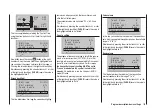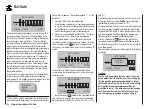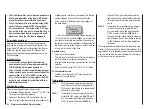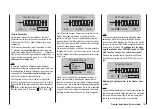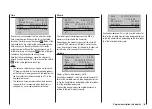
148
Program description: Telemetry menu
SUMI (Sum signal IN).
•
RX SERVO TEST
ALL–MIN : 1000µsec
ALL–MAX : 2000µsec
ALARM VOLT : 3.8V
ALARM TEMP–:–10°C
ALARM TEMP+: 55°C
TEST : START
CH OUT TYPE:
SUMI
Note that the signal only ever moves in one direction:
towards the SUMI.
However, if reception fails, the receiver defined as
SUMI only uses the sum signal coming from the
SUMO if at least one channel at the SUMI is pro-
grammed to Fail-Safe.
If the receiver programmed as the satellite (SUMO)
suffers signal reception failure, the servos connected
to that receiver take up the Fail-Safe positions pro-
grammed in the satellite receiver, regardless of the
primary receiver.
If, in contrast, reception fails at both receivers simul-
taneously, then the receiver software (the version
current at the time of printing these instructions) al-
ways reverts to the SUMO’s fail-safe settings.
Howe-
ver, mutual interactions can certainly not be ruled
out in individual cases, and for this reason we ur-
gently advise you to carry out appropriate tests
BEFORE flying a model.
This receiver configuration is recommended in partic-
ular circumstances: for example, if one of the two re-
ceivers has to be installed in an unfavourable position
in the model, or if there is a danger that the received
signal will be weak in certain flight attitudes, per-
haps due to a turbine, carbon fibre in the airframe, or
a similar problem, with the result that sporadic range
problems might be expected.
For this reason it is essential to connect the most im-
portant control functions to the primary receiver (the
one programmed as SUMI), so that interference to
the satellite receiver (SUMO) does not cause the
model to go out of control.
Telemetry data, such as the voltage of the airborne
power supply, are only sent to the transmitter by the
satellite receiver (configured as SUMO), i. e. all te-
lemetry sensors must be connected to the satellite
receiver (SUMO).
Each receiver should be connected to the shared
power supply using its own power lead. If high cur-
rents can be expected, duplicated power connec-
tions are recommended. However, if each of the two
receivers is to be pow-
ered by its own bat-
tery, then it is essential
to withdraw the cen-
tral (red) wire from one
of the two satellite lead
connectors, as shown
in the illustration.
If you wish to carry out further programming, such
as the Fail-Safe settings, disconnect the three-core
satellite connection between the two receivers, and
switch on just the receiver you wish to address. Note
that you may also need to change the binding se-
quence.
Setting up / displaying sensor(s)
If you select at least one sensor in addition to “Receiver”
in the “SELECT SENSOR” sub-menu of the “
Telemetry
”
menu, which is described below, then you can read
red
1
2
3
out and alter its settings following on from the receiver
pages described in the previous sections.
However, if you wish to have actual access to these
data, then you must connect the selected sensor or
sensors to a receiving system, and set up a working
tele metry link. If you activate at least one sensor, as
described in the next section, you can switch directly be-
tween the individual modules - provided that the sensor
is loaded with the current firmware. However, if you are
using sensors with earlier firmware, it may be necessary
to select “etc.” instead of selecting the sensor directly.
In either case press the Select button
or
of the
left-hand touch-key …
RECEIVER
etc.
VARIO
… and then select the desired module using the same
buttons, working either up or down, e.g.:
GENERAL
RECEIVER
ELECT. AIR
If the General Module is active, as selected in our exam-
ple, you will also see the right-pointing arrow “ ” at top
right on the last receiver page (“RX SERVO TEST”), in
addition to the left-pointing arrow “ ”; this indicates that
further screen pages are available:
Summary of Contents for mx-12 Hott
Page 1: ...Programming Manual 33116 mx 16 HoTT 3 en mx 16...
Page 35: ...35 For your notes...
Page 49: ...49 For your notes...
Page 55: ...55 For your notes...
Page 59: ...59 For your notes...
Page 63: ...63 For your notes...
Page 69: ...69 For your notes...
Page 91: ...91 For your notes...
Page 101: ...101 For your notes...
Page 123: ...123 For your notes...
Page 181: ...181 For your notes...
Page 193: ...193 For your notes...


